Harvey S. Adams
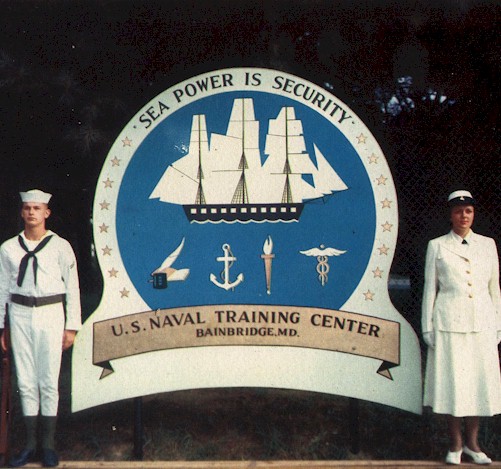
Click to enlarge all photos
Harvey Stanley Adams is my ex-wife's father. "Buddy" as he likes to be known as, joined the Navy fresh out of high school. He started dating Diane Sharkey their senior year. He graduated in June and enlisted shortly there after he reported to boot camp on August 21, 1957 for initial training and was assigned to Company 172.
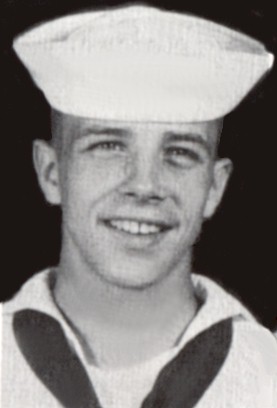
Naval Training Center, Bainbridge, MD
Buddy reported to basic training at the Bainbridge Naval Training center in Maryland. The Naval Training Center-Bainbridge (NTCB) was constructed in 1942 as a training center for World War II Navy recruits. The facility was partially deactivated after World War II, but experienced major activity following the beginning of the Korean crisis in 1951. In the post-war years, NTCB became the host for various schools and functions, including the Naval Preparatory School, the Nuclear Power School, the Naval Reserve Manpower Center, WAVES Headquarters, and a U.S. Naval Hospital. Operations at NTCB were reduced in 1972, and NTCB was formally closed in 1976. Buddy graduated Basic training on October 21 1957.
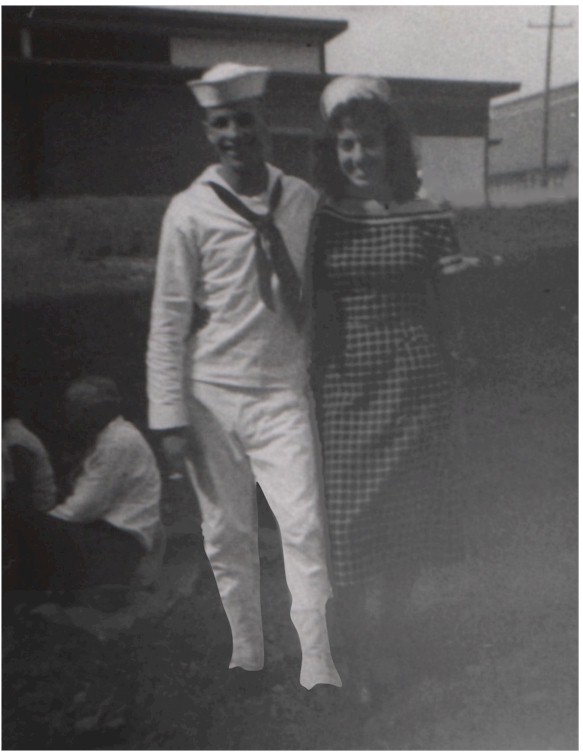
Buddy Adams and Diane Sharkey after graduation of basic training October 1957, Bainbridge , MD
After graduation of boot camp Company 172 he attended Basic Electronics and Electricity school (B&EE) prior to his rating school the Radioman (RM) Class A technical school. School started on January 6, 1958 and lasted for six months until June 27, 1958. There he learned all about communications equipment and message writing necessary for him to do his assigned job with the fleet. Radioman A School also was located at Bainbridge Naval Training Center. Upon completion of his training he reported to his first duty station at the Sidi Yahia Communications station. Buddy would spend the next 18 months there at the Port Lyautey Naval Base in Morocco.
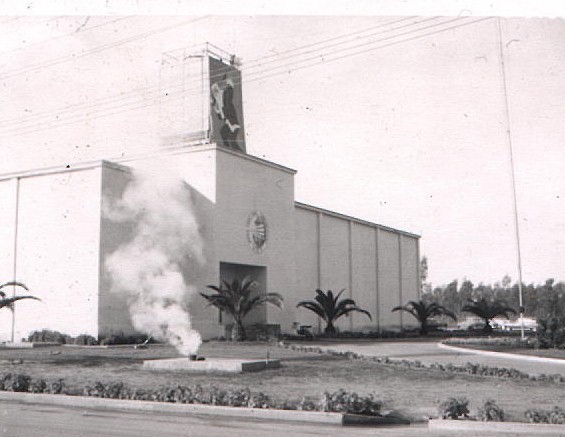
Sidi Yahia Communications center
SIDI YAHIA, MOROCCOBuddy's first duty station was overseas to the Naval Communications Station at Sidi Yahia near the Port Lyautey Naval base in French Morocco. he would spend nearly 18 months there processing radio communications and message traffic for the sixth fleet. On his off hours he would go down to the beaches near the base to relax with his friends. "The beaches were completely deserted and the water was absolutely clear" Buddy would later tell me. "The Arabs never went near the water, we had miles and miles of beaches to ourselves"
 Buddy would transfer in 1959 from Sidi Yahia to the USS Pocono while she was steaming in the "Med" he ended up being transferred from ship to ship by "Boatswains Chair" until he reached the Pocono.
Buddy would transfer in 1959 from Sidi Yahia to the USS Pocono while she was steaming in the "Med" he ended up being transferred from ship to ship by "Boatswains Chair" until he reached the Pocono.
Lebanon Crises 1958While buddy was at Sidi Yahia a major event took place. The Largest and most extensive amphibious operation to take place since the Korean war was the landings at Lebanon near Beruit. "Operation Bluebat" lasted 102 days from July 15 to Oct. 25, and involved the 6th Fleet with over 70 ships and 40,000 sailors, as well as 14,357 ground troops. The Composite Air Strike Force of Naval carrier aircraft as well as U.S. Air Force planes from the 322nd Air Division provided air support. The operation included some 8,509 Army soldiers from the 201st Logistics Command and the 24th Airborne Brigade, built around the 1st Reinforced Airborne Battle Group from Germany. And some 5,842 Marines that landed on the beach came from the 2nd Provisional Marine Force, 2nd Marine Division. Buddy was stationed at Sidi Yahia during this time an processed all the communications traffic for the landings.click here to read about the Lebanon Crises
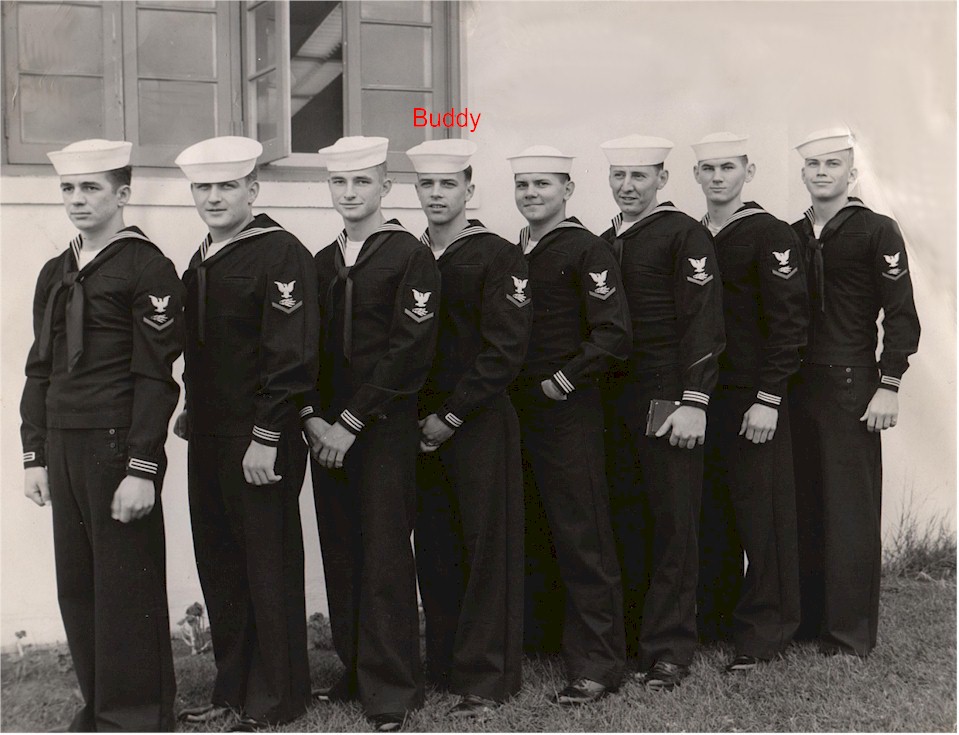
Buddy with his shipmates from the "Radio Shack"in Sidi Yahia
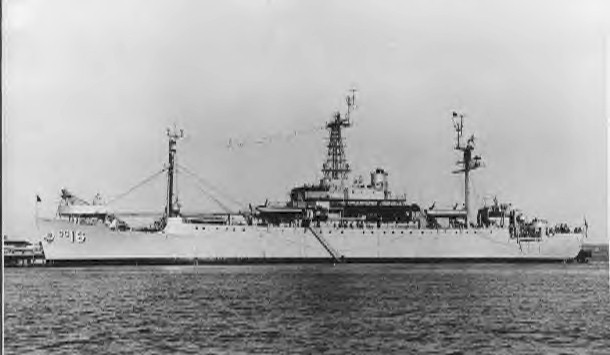
USS POCONO AGC-16<
USS POCONO AGC-16
The Pococnos are range of mountains in eastern Pennsylvania. USS POCONO (AGC-16), an amphibious force flagship, was laid down 30 November 1944 and launched 25 January 1945 by the North Carolina Shipbuilding Co., Wilmington, N.C.; sponsored by Miss Mary V. Carmines of Messick, Va.; acquired by the Navy 15 February 1945; towed to Boston for fitting out; and commissioned 29 December 1945, Captain H. A. Sailor in command. POCONO departed Boston 18 March 1946 for Key West, Fla., en route to Guantanamo Bay for shakedown. The ship then proceeded to Washington, D.C., via Norfolk, and arrived in the nation's capital 7 May. During the next few years, she operated off the Atlantic coast from Newfoundland to Trinidad. Early in 1948, she was flagship of Admiral W. H. P. Blandy, Commander, Atlantic Fleet. POCONO decommissioned at Norfolk 19 June 1949 and moved to Bayonne, N.J., where she entered the Atlantic Reserve Fleet.
POCONO recommissioned 18 August 1951 to serve as flagship for Commander, Amphibious Force, Atlantic Fleet. She operated in this capacity in the Caribbean and off the East Coast of the U.S. until 1956. On 31 October 1956, during the Suez Crisis, the Commander-in-Chief, Naval Forces, Eastern Atlantic and Mediterranean, embarked in POCONO, and remained on board until 13 December.
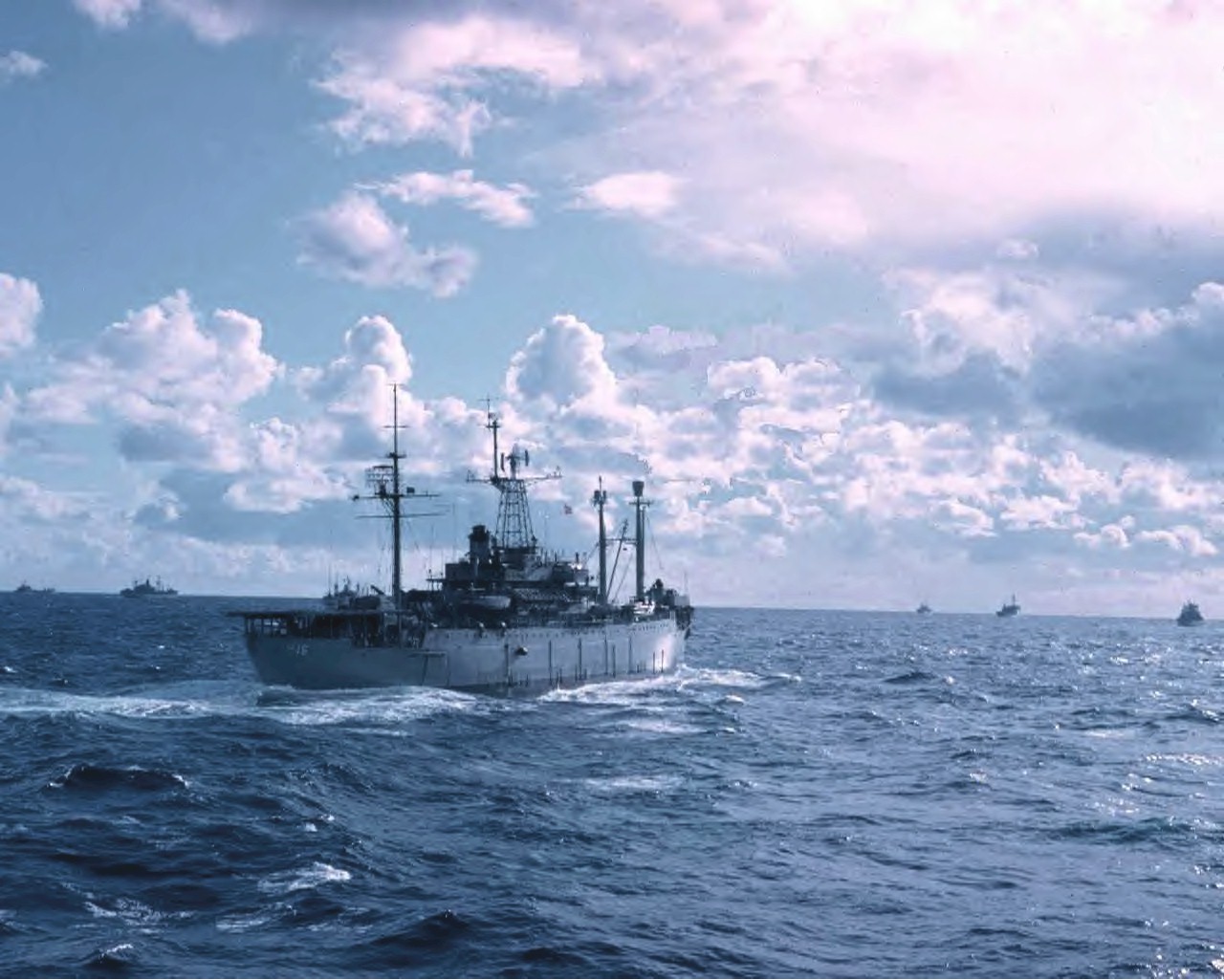
In September 1957, POCONO served as flagship for a 38-ship amphibious task force in NATO exercise "Deepwater" off the coast of Turkey. In early 1958, POCONO served as flagship for operation "Packard X," an Atlantic Fleet amphibious exercise at Onslow Beach, N.C. On June 12, 1958 the POCONO was honored to be chosen the Flagship of U.S. Admiral Jerauld Wright, Commander in Chief, Atlantic Fleet, and to head a group of 12 Fleet Force ships for the 100 ship, 18 nation "International Naval Review" on parade (held at Norfolk, VA.) It was one of the greatest sights ever seen and lasted for 10 days. Thousands of people from all over the United States and the world came to see this multitude of ships on parade. There were 33 ships from foreign nations and the rest were U.S. Navy ships; with all the ships being manned by more than 20,000 officers and men. Included in the United States ships along with the POCONO were the carriers SARATOGA and LEYTE; guided missile cruisers CANBERRA, BOSTON and NORTHAMPTON; the frigate NORFOLK; destroyer STRONG; LST's VERNON COUNTY, WASHTENAW COUNTY, WASHOE COUNTY and WESTCHESTER COUNTY; submarines BARBERO and REGULUS and many other ships. Some of the impressive foreign ships were the British carrier HMS ARK ROYAL, French carrier BOIS-BELLEAU, Canadian destroyer- escort ASSINIBOINE, Turkish destroyers GELIBOLU and GIRESUN and the Spanish four masted barkentine training vessel JUAN SEBASTIAN de ELCANO.
 The ships arrived in port over a period of several days; and as they arrived they announced their arrival like the Belgian, Danish, British and Netherlands contingencies had with flags and pennants flying and guns blasting salutes and their crews in dress uniform standing at attention lining the ship's rails as they pulled into the channel. The day before the review the ships began moving into their assigned places in the review line. By nightfall all 100 were in place. Later in the evening, all ships in the reviewing line that were equipped with search lights turned them on at a pre- arranged signal in a spectacular searchlight display which could be seen by the thousands of people on the shore. Traffic jams resulted at points all along Hampton Roads as people crowded the beaches to see this once in a lifetime display. The review started in Norfolk with the ships stationed in two lines more than 14 miles long all the way from Old Point Comfort on the west to just beyond Lynnhaven Inlet to the east. Three of the ships were designated to be reviewing ships. They were the CANBERRA which steamed slowly by reviewing them while being followed by the BOSTON and the tactical command ship NORTHAMPTON.
The ships arrived in port over a period of several days; and as they arrived they announced their arrival like the Belgian, Danish, British and Netherlands contingencies had with flags and pennants flying and guns blasting salutes and their crews in dress uniform standing at attention lining the ship's rails as they pulled into the channel. The day before the review the ships began moving into their assigned places in the review line. By nightfall all 100 were in place. Later in the evening, all ships in the reviewing line that were equipped with search lights turned them on at a pre- arranged signal in a spectacular searchlight display which could be seen by the thousands of people on the shore. Traffic jams resulted at points all along Hampton Roads as people crowded the beaches to see this once in a lifetime display. The review started in Norfolk with the ships stationed in two lines more than 14 miles long all the way from Old Point Comfort on the west to just beyond Lynnhaven Inlet to the east. Three of the ships were designated to be reviewing ships. They were the CANBERRA which steamed slowly by reviewing them while being followed by the BOSTON and the tactical command ship NORTHAMPTON.

As the reviewing ships passed down the line of assembled warships, naval guns boomed out their salutes to the reviewing dignitaries, and the international salutes were answered by salutes fired from Fort Monroe. The reviewing officer, Secretary of Defense Charles E. Wilson, was embarked in the CANBERRA, while the Secretary of the Navy, Thomas S. Gates was embarked in the BOSTON and Chief of Naval Operations Admiral Arleigh Burke was aboard the NORTHAMPTON. Other dignitaries and the press and guests were embarked on all three ships of the review group. For the rest of that afternoon the review ships steamed past large ships and small ships ranging all the way from the giant U.S. supercarrier SARATOGA to Spain's beautiful 4 masted training vessel. The review was brought to a fitting climax by a mass fly-over by more than 200 Navy and Marine planes and an exhibition of precision flying by the Navy's Blue Angels flying team. This full dress parade of the world's navies was the first one to take place in U.S. waters since 1907 when a review was held commemorating the 300th anniversary of the founding of Jamestown.
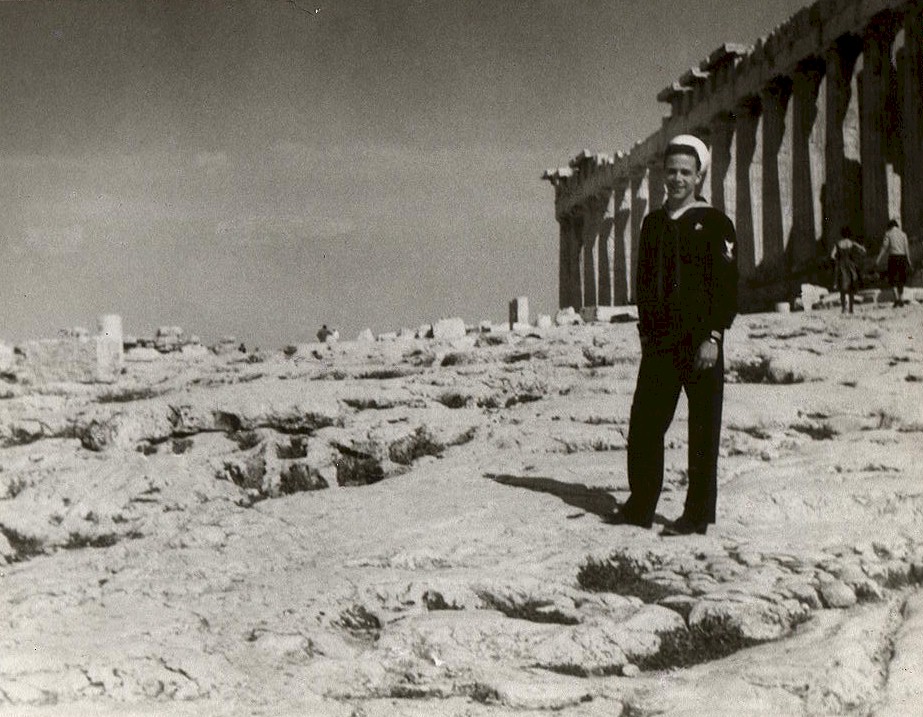
Buddy at the Parthanon in Athens, Greece
The period immediately before and after the review was designated "Fleet Week". During this time sightseers were allowed to visit the POCONO and other U.S. and foreign ships as they were tied up at piers at the Norfolk Naval base and the Submarine-Destroyer piers. In addition, all naval installations in the Norfolk area were open to the visitors who had crowded Norfolk to see the review. With so many foreign sailors in the area speaking a dozen different languages and trying to spend money of 18 different currencies, some "little international incidents" were touched off. The incidents were mostly confined to counter tops where confused clerks tried to figure out how many pesos, piastres, lire, pounds or francs were needed to buy a $3 cowboy hat and equally confused sailors pondered for the native word that would order them a glass of beer. They had spent days sprucing up their ships for public display and now they had swarmed into town for a deserved liberty. Flags lined the streets and flew from every ship. The sailors emptied stamp machines delightedly and bought post cards by the thousands. They consumed banana splits and ice cream sodas and walked gaily down the streets chewing gum. The whole town became upset when a Turkish sailor lost a $50 bill and was unable to pay for his meal at a restaurant or explain through sign language what had happened. After 18 officials of the police department, and shore patrol had gathered to straighten out the affair, the sailor finally explained through interpreters that the bill had disappeared. He was given the meal free and later a Norfolk citizen raised the $50 to reimburse the sailor for his loss.
Cyd Charisse, the then star of MGM's "Silk Stockings" was named "Sweetheart of the Navies" for the naval review week.
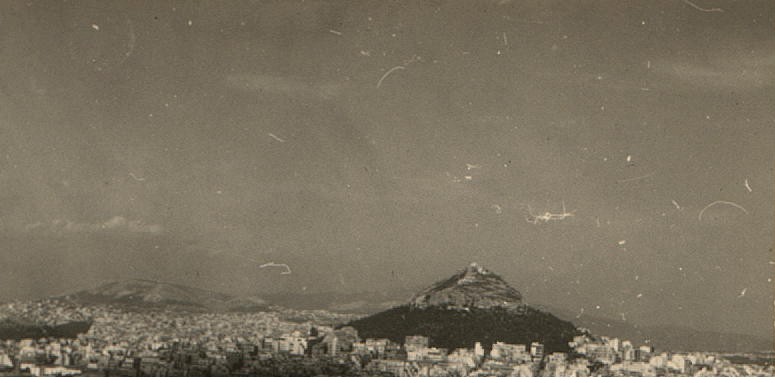
Straights of Gibralter from the African view
On June 23, 1958 the POCONO departed the United States bound for the Mediterranean. She was diverted to Beirut, Lebanon where she controlled the landing that assisted that nation. During her three months stay in Beirut, she performed such functions as air control and command communications. Because of the Beirut Crisis the regular six-month Mediterranean deployment was extended to nine months, with the POCONO returning to Norfolk, VA. on March 20, 1959.
On January 11, 1960 the POCONO again departed from Norfolk for the Mediterranean where she participated in four amphibious landing exercises, including a joint NATO landing at Porto Scudo, Sardinia before she returned to Norfolk on June 14, 1960. She then participated in Caribbean landing exercises in July 1960 and February 1961. On April 1, 1961 she departed again for the Mediterranean, and participated in several amphibious landings, including a joint NATO landing at Saros Gulf, Turkey. She then returned to Norfolk on October 12, 1961.
After an extensive overhaul she departed Norfolk on April 10, 1962 for the Caribbean. On July 23, 1962 she departed there for the Mediterranean. When the Cuban Crisis arose, the POCONO was recalled to the United States. She carried the flag of Commander, Amphibious Forces, Atlantic, and remained in operational readiness in Norfolk. For the rest of 1962 and 1963 and most of 1964 the POCONO remained in the United States.
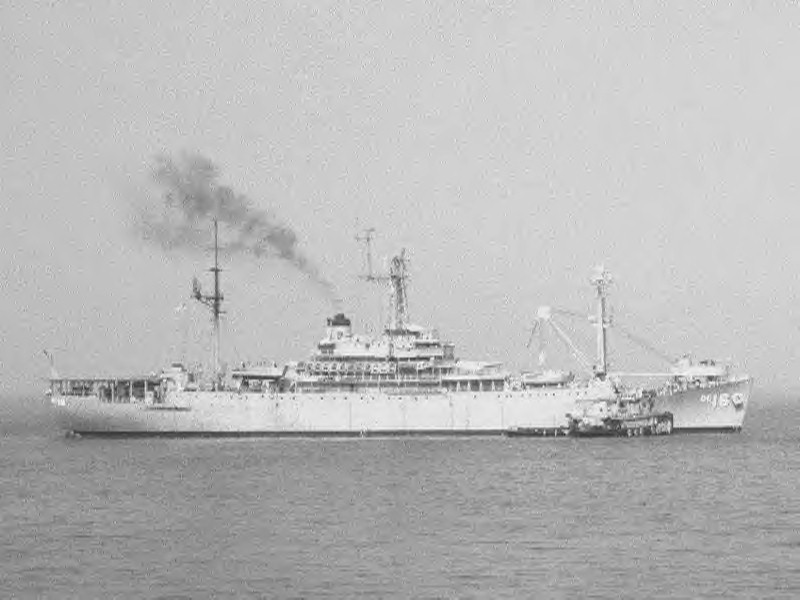
In early 1964, she participated in two landing exercises at Onslow Beach, N.C. On 11 October, she deployed for "Steelpike I", which included an assault with helicopter landings at Huelva Bay, Spain. She returned to Norfolk 25 November. POCONO departed Norfolk 21 May 1965 enroute to Santo Domingo, Dominican Republic, to aid in the peace-keeping operation there. She provided the platform from which Vice Admiral McCain (Senator McCain's father) directed the naval forces' support of this operation. From late 1965 through early 1968, POCONO participated in further operations in the Caribbean and off the east coast of the U.S., returning to Norfolk 24 February 1968.
Pocono was subsequently decommissioned in 1971 and later sold for scrap in 1976.

Francis Gary Powers on Trial August 1960
U-2 Incident
While Buddy was stationed on the USS Pocono the Cold War suddenly was at the forefront of the news again in 1960. On May 1, 1960 a U2 plane piloted by Gary Powers was shotdown by a SAM-2 missile. Powers was captured with all of his gear and wreckage to the plane. President Eisenhower had known about previous flights, but denied that the plane was flying in Soviet airspace.
Confrontation between the United States and the Soviet Union that began with the shooting down of a U.S. U-2 reconnaissance plane over the Soviet Union and that caused the collapse of a summit conference in Paris between the United States, the Soviet Union, Great Britain, and France.
On May 5 the Soviet premier Nikita S. Khrushchev told the Supreme Soviet of the U.S.S.R. that an American spy plane had been shot down on May 1 over Sverdlovsk (now Yekaterinburg), referring to the flight as an "aggressive act" by the United States. On May 7 he revealed that the pilot of the plane, Francis Gary Powers, had parachuted to safety, was alive and well in Moscow, and had testified that he had taken off from Peshawar, in Pakistan, with the mission of flying across the Soviet Union over the Aral Sea and via Sverdlovsk, Kirov, Arkhangelsk, and Murmansk to Bodö military airfield in Norway, collecting intelligence information en route. Powers admitted working for the U.S. Central Intelligence Agency.
On May 7 the United States stated that there had been no authorization for any such flight as Khrushchev had described, although a U-2 probably had flown over Soviet territory. The Soviet Union refused to accept that the U.S. government had had no knowledge of the flights and on May 13 sent protest notes to Turkey, Pakistan, and Norway, which in turn protested to the United States, seeking assurances that no U.S. aircraft would be allowed to use their territories for unauthorized purposes.
On May 16 in Paris Khrushchev declared that the Soviet Union could not take part in the summit talks unless the U.S. government immediately stopped flights over Soviet territory, apologized for those already made, and punished the persons responsible. The response of President Dwight D. Eisenhower, promising to suspend all such flights during the remainder of his presidency, did not satisfy the Soviet Union, and the conference was adjourned on May 17.
Francis Gary Powers was tried (August 17-19) and sentenced to 10 years' confinement, but he was exchanged for the Soviet spy Rudolf Abel on Feb. 10, 1962.

Wreckage of a CIA plane shot down over Cuba during the invasion
The Bay of Pigs Invasion
Another Cold war incident that occured while Bubby was on Active duty was the Bay Of Pigs Invasion. The Bay of Pigs Invasion was an unsuccessful attempt by United States-backed Cuban exiles to overthrow the government of the Cuban dictator Fidel Castro. Increasing friction between the U.S. government and Castro's leftist regime led President Dwight D. Eisenhower to break off diplomatic relations with Cuba in January 1961. Even before that, however, the Central Intelligence Agency had been training anti-revolutionary Cuban exiles for a possible invasion of the island. The invasion plan was approved by Eisenhower's successor, John F. Kennedy.
On April 17, 1961 about 1300 exiles, armed with U.S. weapons, landed at the Bahía de Cochinos (Bay of Pigs) on the southern coast of Cuba. Hoping to find support from the local population, they intended to cross the island to Havana. It was evident from the first hours of fighting, however, that the exiles were likely to lose. President Kennedy had the option of using the U.S. Air Force against the Cubans but decided against it. Consequently, the invasion was stopped by Castro's army. By the time the fighting ended on April 19, 90 exiles had been killed and the rest had been taken as prisoners.
The failure of the invasion seriously embarrassed the young Kennedy administration. Some critics blamed Kennedy for not giving it adequate support and others for allowing it to take place at all. The captured exiles were later ransomed by private groups in the U.S.
Additionally, the invasion made Castro wary of the U.S. He was convinced that the Americans would try to take over the island again. From the Bay of Pigs on, Castro had an increased fear of a U.S. incursion on Cuban soil.
for more on the bay of pigs click here
After the Navy
Buddy while still in the service, married his girlfriend Diane Sharkey and they had three children together. Debbie, Donna and David. Buddy left the Navy in 1961 and returned to civilian life. He later separated from Diane and divorced. He now resides at Carmel, NY with his wife Carol.
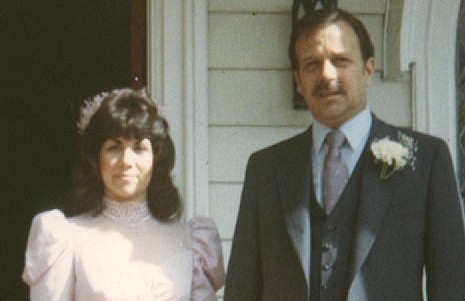
Carol and Buddy Adams 1984
<
HOME
















